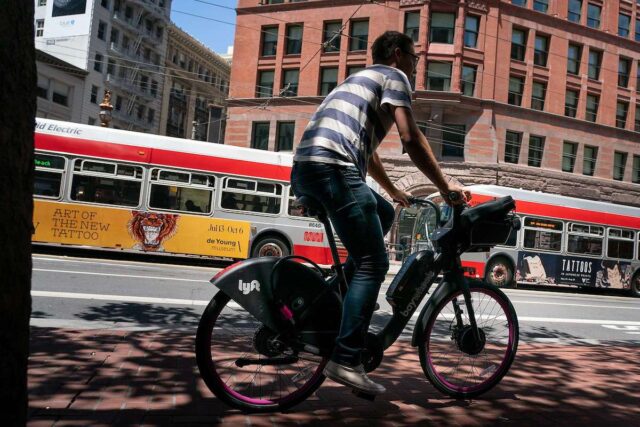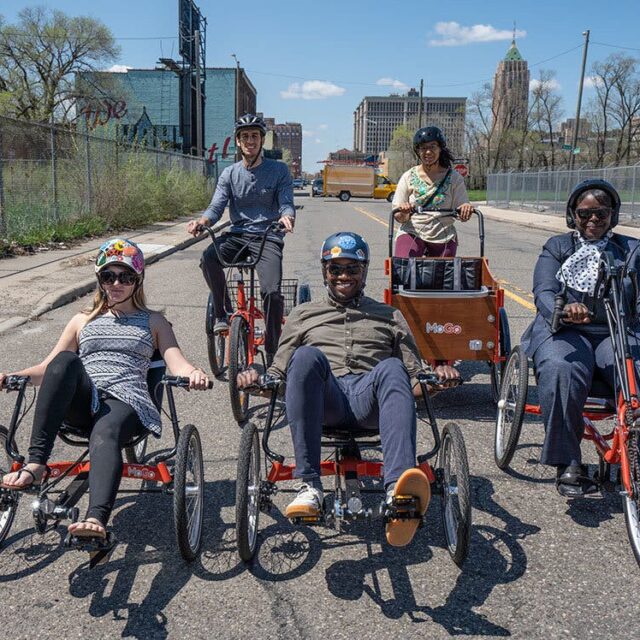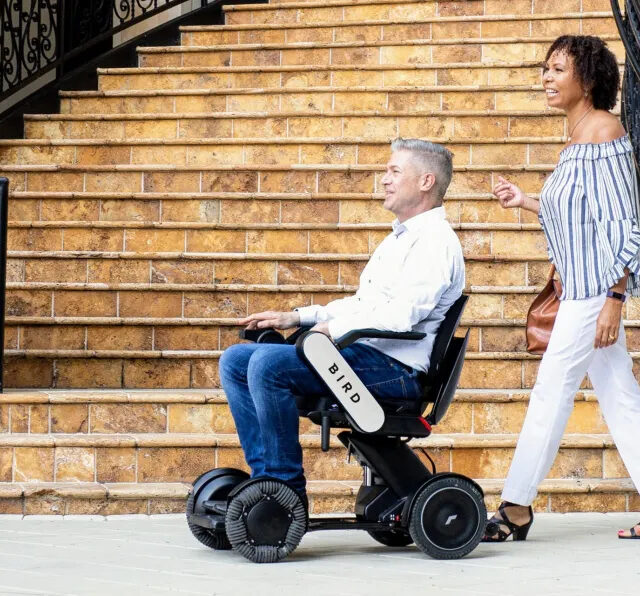The Two Sides of California’s Bike Share Bill
by Kiran Herbert, Communications Manager
June 14, 2022
Advocates of A.B. 371 believe it will help keep pedestrians safe, while others say it could kill shared micromobility in the state.

Photo credit: Paul Kuroda
For the last few months, a California shared micromobility bill intended to protect pedestrians from irresponsible users of shared bikes and scooters has positioned various advocacy groups at odds. On the one hand, disability groups and pedestrian advocates argue it will make sidewalks safer for pedestrians while sustainable transportation arguments believe it threatens the equitable expansion of shared micromobility. Although portions of California Assembly Bill 371 Shared Mobility Devices: Insurance and Tracking (A.B. 371) have broad support, the provision that’s causing some contention would increase insurance requirements for scooter and bike share operators.
A.B. 371 is sponsored by some disability rights groups, including the California Council for the Blind, as well as pedestrian safety groups and the Consumer Attorneys of California. Opponents include many shared micromobility operators, some smart growth organizations, and bike advocacy groups, including the California Bicycle Coalition, also known as CalBike.
Initially, the bill would have completely shifted California’s shared micromobility landscape, expanding insurance requirements to include third-party liability coverage of a minimum of $100K individually in case of negligence by the user. That means that if a scooter or bike share rider were to hit and injure a pedestrian, then the operator of the device they were on would be liable to pay. This would apply to every operator, including nonprofit and public operators, even if the operator had no fault in the crash. In California, where insurance costs for companies are already relatively high, the bill would have likely driven many operators out of business. Initially, CalBike even dubbed A.B. 371 the “Kill Bike-Share Bill.”
Advocates against the bill pointed to the fact that in California, the minimum insurance requirement for personal automobiles is $15K per person/$30K per accident — why, they asked, should the minimum requirements for a scooter operator be so much greater than those of a driver, especially when the latter is far more dangerous? On June 9, after the author’s office held a series of productive conversations with a coalition of major shared micromobility providers, the bill was revised to drop the minimum from $100K to $10K.
Even with the changes, the bill would likely hurt the growth of shared micromobility in the state. “If passed, the bill would make it a lot more difficult to expand bike share as an equitable transit solution integrated with public transit,” says Dave Snyder, executive director at CalBike, adding that fully integrating bike share with California’s buses and trains is also key to reducing greenhouse gas emissions. With the new $10K minimum, however, Snyder thinks it will be hard to stop A.B. 371 from going into effect, largely due to a new precedent set by the City of Cincinnati imposing a similar $10,000 requirement on Bird.
“It might not be prohibitively expensive and pedestrians do need a way to cover any injuries,” says Snyder. “The other issue is whether the bill makes a distinction between bikes and scooters — it’s really important to us to have it not apply to bikes and e-bikes.”
As it’s currently written, the bill makes no distinction between scooters, bikes, and e-bikes. Snyder is hopeful that the bill’s authors would make a distinction between bikes and scooters, and that the $10K minimum provision wouldn’t apply to e-bikes. Not only are bikes safer than scooters but they have more utility as mobility devices. Plus, since bicycling is a form of active transportation, it has accompanying public health benefits. Scooters also tend to be the major culprit when it comes to sidewalk clutter and pedestrian complaints.
Snyder notes that e-bikes can be governed to go at a slow speed in a shared system and CalBike is recommending that speed be set at 15-17 mph. Currently, bike share systems cap e-bike speeds at varying levels. The country’s largest system, Citi Bike in New York City, is capped at 18 mph. In Los Angeles, BCycle caps their e-bikes at 17 mph. In Chicago, the Divvy system launched with a 15 mph hour limit but in 2021, the limit was raised to 20 mph (that latter is the speed at which most personal e-bikes cease to provide pedal assistance). In San Francisco, Lyft’s e-bikes are also capped at 20 mph.
Synder is quick to assuage any doubts that CalBike cares about pedestrian safety or those with disabilities. “I’m 100% agreeing that it’s important to have safe sidewalks — the single most important thing for equitable and inclusive cities when it comes to transportation is the ability to walk down the sidewalk safely,” says Snyder. “We need to make sure that the problem of these devices on the sidewalks doesn’t happen in the first place. If our strategy is to give injured parties a little bit of money to pay for their injuries, we’ve failed. We need to prevent injuries in the first place.”
The bill also doesn’t account for the fact that scooter and bike users choose to ride on the sidewalk only when they don’t feel safe riding on the road. While CalBike acknowledges the need for more comprehensive bike infrastructure, Synder believes that pedestrians on the sidewalk should always be the top priority. CalBike plans on suggesting that the state consider a stricter permit requirement, one that would require operators to keep devices off of the sidewalk except when parking at a designated spot.
There are sections of A.B. 371 that CalBike supports as is, including one that would require braille markings on devices themselves, so that if a blind person reaches an improperly parked bike or scooter they could easily report it. While still not ideal, with the personal injury or death insurance requirement lowered to $10K, the bill is now more palatable for opponents. Without unanimous opposition from cities and the shared micromobility industry, Synder plans to focus on ensuring a distinction is made in the bill between bikes and scooters.
Letters for or against the bill need to be in by June 15, 2022 — California residents can make their voices heard against the bill through this PeopleForBikes Action Alert. A.B. 371 is scheduled for a Senate Insurance Committee hearing on June 22, 2022, where if passed, it would go back to California State Assembly for concurrence before being handed off for Governor Gavin Newsom to sign some time in the fall. If he were to sign it, A.B. 371 would go into effect in July 2023. While the bill is specific to California it could set a precedent for the entire shared micromobility industry, affecting operations everywhere.
The Better Bike Share Partnership is funded by The JPB Foundation as a collaboration between the City of Philadelphia, the National Association of City Transportation Officials (NACTO) and the PeopleForBikes Foundation to build equitable and replicable bike share systems. Follow us on Facebook, Twitter and Instagram or sign up for our weekly newsletter. Got a question or a story idea? Email kiran@peopleforbikes.org.



